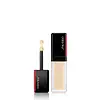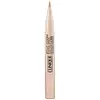What's inside
What's inside
 Key Ingredients
Key Ingredients

 Benefits
Benefits

 Concerns
Concerns

 Ingredients Side-by-side
Ingredients Side-by-side

Dimethicone
EmollientWater
Skin ConditioningCI 77891
Cosmetic ColorantCI 77492
Cosmetic ColorantPropanediol
SolventButylene Glycol
HumectantPEG-9 Polydimethylsiloxyethyl Dimethicone
EmulsifyingCI 77491
Cosmetic ColorantGlycerin
HumectantHydrogenated Polydecene
EmollientMica
Cosmetic ColorantCyclopentasiloxane
EmollientDisteardimonium Hectorite
StabilisingTrimethylsiloxysilicate
EmollientPEG-10 Dimethicone
Skin ConditioningBis-Butyldimethicone Polyglyceryl-3
CleansingCI 77499
Cosmetic ColorantSorbitan Sesquiisostearate
EmulsifyingDimethicone/Vinyl Dimethicone Crosspolymer
Skin ConditioningPhenoxyethanol
PreservativeIsostearic Acid
CleansingPolysilicone-2
Aluminum Hydroxide
EmollientPolymethylsilsesquioxane
Trisodium EDTA
Lithium Magnesium Sodium Silicate
AbsorbentTriethoxycaprylylsilane
Tocopheryl Acetate
AntioxidantNacre Powder
AbrasiveMagnesium Aluminometasilicate
AbsorbentSodium Citrate
BufferingPEG/PPG-19/19 Dimethicone
EmulsifyingPolyquaternium-51
Skin ConditioningTrimethylsiloxysilylcarbamoyl Pullulan
Sodium Metabisulfite
AntioxidantThymus Serpyllum Extract
Skin ConditioningCitric Acid
BufferingSilica
AbrasiveTocopherol
AntioxidantStearic Acid
CleansingSodium Acetylated Hyaluronate
HumectantDimethicone, Water, CI 77891, CI 77492, Propanediol, Butylene Glycol, PEG-9 Polydimethylsiloxyethyl Dimethicone, CI 77491, Glycerin, Hydrogenated Polydecene, Mica, Cyclopentasiloxane, Disteardimonium Hectorite, Trimethylsiloxysilicate, PEG-10 Dimethicone, Bis-Butyldimethicone Polyglyceryl-3, CI 77499, Sorbitan Sesquiisostearate, Dimethicone/Vinyl Dimethicone Crosspolymer, Phenoxyethanol, Isostearic Acid, Polysilicone-2, Aluminum Hydroxide, Polymethylsilsesquioxane, Trisodium EDTA, Lithium Magnesium Sodium Silicate, Triethoxycaprylylsilane, Tocopheryl Acetate, Nacre Powder, Magnesium Aluminometasilicate, Sodium Citrate, PEG/PPG-19/19 Dimethicone, Polyquaternium-51, Trimethylsiloxysilylcarbamoyl Pullulan, Sodium Metabisulfite, Thymus Serpyllum Extract, Citric Acid, Silica, Tocopherol, Stearic Acid, Sodium Acetylated Hyaluronate
Dimethicone
EmollientWater
Skin ConditioningIsopentyldiol
HumectantPolymethylsilsesquioxane
Trisiloxane
Skin ConditioningMethyl Trimethicone
Skin ConditioningPentaerythrityl Tetraethylhexanoate
EmollientPhenyl Trimethicone
Skin ConditioningTribehenin
EmollientPEG-10 Dimethicone
Skin ConditioningHydrogenated Polyisobutene
EmollientSilica
AbrasiveLecithin
EmollientPolysilicone-11
Lauryl PEG-9 Polydimethylsiloxyethyl Dimethicone
Skin ConditioningCaffeine
Skin ConditioningDimethicone/PEG-10/15 Crosspolymer
Dimethicone/Vinyl Dimethicone Crosspolymer
Skin ConditioningPropylene Carbonate
SolventTriethoxycaprylylsilane
Alumina
AbrasiveTriethyl Citrate
MaskingSodium Chloride
MaskingDisteardimonium Hectorite
StabilisingLaureth-7
EmulsifyingSodium Hyaluronate
HumectantDipropylene Glycol
HumectantSodium Dehydroacetate
PreservativeDisodium EDTA
Phenoxyethanol
PreservativeCI 77891
Cosmetic ColorantCI 77491
Cosmetic ColorantCI 77492
Cosmetic ColorantCI 77499
Cosmetic ColorantCI 77163
Cosmetic ColorantMica
Cosmetic ColorantDimethicone, Water, Isopentyldiol, Polymethylsilsesquioxane, Trisiloxane, Methyl Trimethicone, Pentaerythrityl Tetraethylhexanoate, Phenyl Trimethicone, Tribehenin, PEG-10 Dimethicone, Hydrogenated Polyisobutene, Silica, Lecithin, Polysilicone-11, Lauryl PEG-9 Polydimethylsiloxyethyl Dimethicone, Caffeine, Dimethicone/PEG-10/15 Crosspolymer, Dimethicone/Vinyl Dimethicone Crosspolymer, Propylene Carbonate, Triethoxycaprylylsilane, Alumina, Triethyl Citrate, Sodium Chloride, Disteardimonium Hectorite, Laureth-7, Sodium Hyaluronate, Dipropylene Glycol, Sodium Dehydroacetate, Disodium EDTA, Phenoxyethanol, CI 77891, CI 77491, CI 77492, CI 77499, CI 77163, Mica
Ingredients Explained
These ingredients are found in both products.
Ingredients higher up in an ingredient list are typically present in a larger amount.
Ci 77491 is also hydrated iron III oxide. It's sole purpose is to give a red/pink hue to products.
Iron III oxides are classified as inorganic chemicals for coloring.
Synthetically created Ci 77491 is considered safer than those naturally found. This is because the synthetically created version may contain less impurities. Iron oxides are generally non-toxic and non-allergenic.
Learn more about CI 77491Ci 77492 is also hydrated iron III oxide. It's sole purpose is to give a yellow hue to products.
Iron III oxides are classified as inorganic chemicals for coloring.
Synthetically created Ci 77492 is considered safer than those naturally found. This is because the synthetically created version may contain less impurities. Iron oxides are generally non-toxic and non-allergenic.
Learn more about CI 77492Ci 77499 is also hydrated iron III oxide. It is created from mixing red and black iron oxides. This helps give shades of darkness to a product.
Iron III oxides are classified as inorganic chemicals for coloring.
Ci 77891 is a white pigment from Titanium dioxide. It is naturally found in minerals such as rutile and ilmenite.
It's main function is to add a white color to cosmetics. It can also be mixed with other colors to create different shades.
Ci 77891 is commonly found in sunscreens due to its ability to block UV rays.
Learn more about CI 77891Dimethicone is a type of synthetic silicone created from natural materials such as quartz.
What it does:
Dimethicone comes in different viscosities:
Depending on the viscosity, dimethicone has different properties.
Ingredients lists don't always show which type is used, so we recommend reaching out to the brand if you have questions about the viscosity.
This ingredient is unlikely to cause irritation because it does not get absorbed into skin. However, people with silicone allergies should be careful about using this ingredient.
Note: Dimethicone may contribute to pilling. This is because it is not oil or water soluble, so pilling may occur when layered with products. When mixed with heavy oils in a formula, the outcome is also quite greasy.
Learn more about DimethiconeThis ingredient is a silicone used to improve the texture of products and absorb oil. It does not get absorbed into the skin.
Like other silicones, Dimethicone/Vinyl Dimethicone Crosspolymer helps condition the skin by creating a barrier. In this sense, it can act as an emollient and trap moisture in.
This ingredient is a type of elastomer.
Learn more about Dimethicone/Vinyl Dimethicone CrosspolymerDisteardimonium Hectorite comes from the clay mineral named hectorite. It is used to add thickness to a product.
It can also help stabilize a product by helping to disperse other ingredients.
Hectorite is a rare, white clay mineral.
Learn more about Disteardimonium HectoriteMica is a naturally occurring mineral used to add shimmer and color in cosmetics. It can also help improve the texture of a product or give it an opaque, white/silver color.
Serecite is the name for very fine but ragged grains of mica.
This ingredient is often coated with metal oxides like titanium dioxide. Trace amounts of heavy metals may be found in mica, but these metals are not harmful in our personal products.
Mica has been used since prehistoric times throughout the world. Ancient Egyptian, Indian, Greek, Roman, Aztec, and Chinese civilizations have used mica.
Learn more about MicaPeg-10 Dimethicone is silicone with conditioner and emulsifier properties. It mostly acts as an emollient in skincare and and humectant in haircare.
According to the manufacturer, acidic formulations decrease the stability of this ingredient. It works best in neutral or near neutral formulations.
Phenoxyethanol is a preservative that has germicide, antimicrobial, and aromatic properties. Studies show that phenoxyethanol can prevent microbial growth. By itself, it has a scent that is similar to that of a rose.
It's often used in formulations along with Caprylyl Glycol to preserve the shelf life of products.
Polymethylsilsesquioxane is a silicone used as a film forming agent.
When applied to the skin, this ingredient creates an invisible film on the surface. This film still allows oxygen to pass through, but prevents moisture from escaping. This can help condition and hydrate the skin. It also leaves a silky feel when applied.
Polymethylsilsesquioxane has not been shown to clog pores. It has been deemed safe to use up to 55%, but most cosmetics use much less.
If you have concerns about using this ingredient, we recommend speaking with a professional.
Learn more about PolymethylsilsesquioxaneSilica, also known as silicon dioxide, is a naturally occurring mineral. It is used as a fine, spherical, and porous powder in cosmetics.
Though it has exfoliant properties, the function of silica varies depending on the product.
The unique structure of silica enhances the spreadability and adds smoothness, making it a great texture enhancer.
It is also used as an active carrier, emulsifier, and mattifier due to its ability to absorb excess oil.
In some products, tiny microneedles called spicules are made from silica or hydrolyzed sponge. When you rub them in, they lightly polish away dead skin layers and enhance the penetration of active ingredients.
Learn more about SilicaTriethoxycaprylylsilane is a silicone used to bind and stabilize ingredients.
As an emulsifier, it helps prevent ingredients from separating. This can help elongate the shelf life of products.
Triethoxycaprylylsilane is often used to coat mineral sunscreens ingredients to help give a better feel. It also helps reduce oxidative stress in sunscreens.
Learn more about TriethoxycaprylylsilaneWater. It's the most common cosmetic ingredient of all. You'll usually see it at the top of ingredient lists, meaning that it makes up the largest part of the product.
So why is it so popular? Water most often acts as a solvent - this means that it helps dissolve other ingredients into the formulation.
You'll also recognize water as that liquid we all need to stay alive. If you see this, drink a glass of water. Stay hydrated!
Learn more about Water